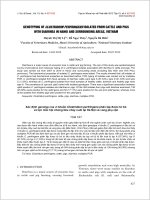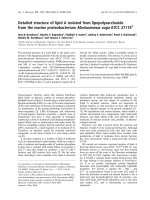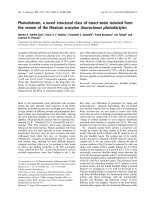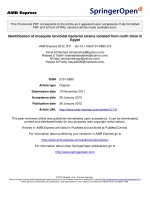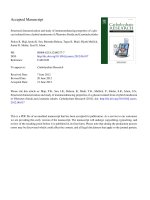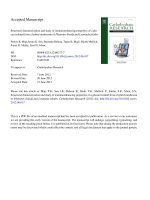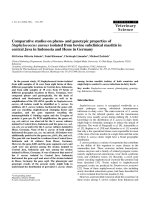antimicrobial susceptibility testing of bacterial agents isolated from asian seabass (lates calcarifer)
Bạn đang xem bản rút gọn của tài liệu. Xem và tải ngay bản đầy đủ của tài liệu tại đây (532.41 KB, 33 trang )
CAN THO UNIVERSITY
COLLEGE OF AQUACULTURE AND FISHERIES
ANTIMICROBIAL SUSCEPTIBILITY TESTING OF
BACTERIAL AGENTS ISOLATED FROM
ASIAN SEABASS (Lates calcarifer)
By
TRAN HUU TINH
A thesis submitted in partial fulfillment of the requirements for
the degree of Bachelor of Science in Aquaculture
Can Tho City, January 16, 2013
CAN THO UNIVERSITY
COLLEGE OF AQUACULTURE AND FISHERIES
ANTIMICROBIAL SUSCEPTIBILITY TESTING OF
BACTERIAL AGENTS ISOLATED FROM
ASIAN SEABASS (Lates calcarifer)
By
TRAN HUU TINH
A thesis submitted in partial fulfillment of the requirements for
the degree of Bachelor of Science in Aquaculture
Supervisor
Dr. TU THANH DUNG
Can Tho City, January 16, 2013
ACKNOWLEDGEMENT
First of all, the author wishes to express special thanks to his supervisor, Dr. Tu Thanh
Dung, for her valuable guidance, advice, and encouragement. He would also like to
dedicate his great appreciation to Dr. Tran Thi Tuyet Hoa for her kind help in finishing
the research.
Many thanks are also given to all other doctors of the College of Aquaculture and
Fisheries, and especially to those at the Department of Aquatic Pathology for
providing him with great working and learning conditions.
The author would love to express his sincere appreciation to many of his friends,
especially Nguyen Minh Tri, Nguyen Bao Trung, Tran Hoa Cuc, and Tran My Han for
their kind help throughout the experiment period.
Last but not least, the author really wishes to thank his academic adviser, Dr. Pham
Minh Duc, who was guiding and encouraging him over the last four years, and his
family for their great lifetime support which makes everything possible for him.
The author,
Tran HuuTinh
i
ABSTRACT
The purpose of this study was to isolate some bacterial agents from Asian sea bass,
and then perform antimicrobial susceptibility tests. Bacterial samples were collected in
Soc Trang, Dong Nai, and Vung Tau during June to October – 2012. A total number of
23 bacterial isolates were isolated from both healthy and diseased fish with
hemorrhages on skin, and exophthalmia. The results showed that 5 out of 23 isolates
were identified as Vibrio vulnificus, 13 isolates were confirmed as Streptococcus iniae,
and the rest 5 isolates were of Aeromonas hydrophila. Most of the isolates were tested
for susceptibility with 11 antimicrobial agents with both disk diffusion and broth
dilution methods. The results showed that all bacterial isolates were completely
resistant to colistin. Isolates of Vibrio vulnificus were sensitive to most other types of
antibiotics used, but showed intermediate susceptibility to ampicillin and cefotaxime.
A. hydrophila isolates were resistant to not only colistin, but also flumequine,
norfloxacin, and enrofloxacin, and were susceptible to other antibiotics used. Isolates
of Streptococcus iniae were resistant to flumequine, but very sensitive to the rest types
of antibiotics. The minimal inhibitory concentration (MIC) of colistin to Streptococcus
iniae was highest (>512µm/ml), and that of erythromycin was lowest (0.0325µm/ml)
of the six antibiotics used in this experiment. Besides, MICs of the other four
antibiotics were also low, ranging from 0.125 to 4µm/ml.
ii
TABLES OF CONTENTS
ACKNOWLEDGEMENT
i
ABSTRACT
ii
TABLES OF CONTENTS
iii
LIST OF FIGURES
v
LIST OF TABLES
vi
CHAPTER 1
1
1.1 Background of study
1.2 Research objectives
1.3 Research contents
CHAPTER 2
1
2
2
3
2.1 Asian sea bass (Lates calcarifer)
2.2 Major diseases in sea bass
2.2.1 Vibriosis
2.2.2 Bacterial hemorrhagic septicemia
2.2.3 Streptococcosis
2.3 Antibiotics
2.3.1 Antibiotics in aquaculture
2.3.2 Antimicrobial resistance
CHAPTER 3
3
3
3
4
4
5
5
5
7
3.1 Time and sites of study
3.2 Materials
3.3 Methods
3.3.1 Fish sampling
3.3.2 Bacterial isolation
3.3.3 Bacterial identification
3.3.4 Antimicrobial susceptibility testing
3.3.5 Minimal inhibitory concentration (MIC) test
3.3.6 Data analysis
CHAPTER 4
4.1 Fish sampling and bacterial isolations
4.2 Bacterial identification
4.3 Antimicrobial susceptibility testing
4.3.1 Disk diffusion method
4.3.2 Broth dilution method
iii
7
7
7
7
8
8
8
9
10
11
11
12
13
13
15
CHAPTER 5
16
5.1 Conclusions
5.2 Recommendations
REFERENCES
16
16
17
APPENDICES
20
Appendix 1.Major antimicrobial drugs used in aquaculture
Appendix 2.Fish Disease Diagnosis Form
Appendix 3.Some biochemical tests used in bacterial identification
Appendix 4.Preparation of culture dilution series per isolate
Appendix 5.API 20E and API 20STREP kit results
iv
20
21
22
24
25
LIST OF FIGURES
Figure 4.1 Diseased signs of sea bass………………………………………...Page 11
Figure 4.2 Different colony morphologies of bacterial isolates……………...Page 12
Figure 4.3 Gram stains of V. vulnificus, A. hydrophila, and S. iniae…………Page 13
v
LIST OF TABLES
Table 4.1 Susceptibility pattern of three bacterial species……………………...Page 14
Table 4.2 MIC values of six antibiotics for two S. iniae isolates………………Page 15
vi
CHAPTER 1
INTRODUCTION
1.1 Background of study
Sea bass (Lates calcarifer) is a large, euryhaline member of the family Centropomidae
that is widely distributed in the Indo-West Pacific Ocean. This species can tolerate
crowding and has wide physiological tolerances, and rapid growth, reaching
harvestable size (350g - 3kg) in six months to two years. Aquaculture of sea bass
commenced in the 1970s in Thailand, and rapidly spread throughout much of
Southeast Asia because of high market value and demand of this species (FAO, 2012).
In Vietnam, sea bass culture was started in the early 1990s in small scales due to the
lack of seeds, but has started to develop quickly in the recent years since fingerlings
can be artificially spawned (Tuan et al., 2000).
Like any other species, sea bass, cultured either ponds or cages, often get diseases such
as viral nervous necrosis, lymphocystis disease caused by viruses, vibriosis by Vibrio
spp., bacterial hemorrhagic septicemia by Aeromonas spp., columnaris disease by
Flavobacterium spp. (FAO, 2012) which can greatly reduce the profitability of the
systems. Vibriosis caused by Vibrio spp. is the most common bacterial disease
affecting culture Sea bass (Wee and Leong, 1986, cited by Chan, 1997). Diseased fish
usually have darkening, lethargy, anorexia, reddened ulcerations on body, and
reddened abdominal fluid (FAO, 2012).
Antibiotics, widely used for treatment of bacterial infections, including vibriosis, can
result in antimicrobial resistance of bacteria if misused. Bacterial resistance often
causes treatment failure since antibiotics normally used for treatment of specific
disease are no longer effective (Tenover, 2006). Higher dosages of antibiotics may be
then applied, and hopefully can cure the illness. However, residues in food product are
not favorable to consumers. Besides, resistant characteristics can readily spread
through bacterial populations (Kumarasamy et al., 2010). The continuous use of
antibiotics increases the risks of antibiotic residues in fish meat and fish products.
Presently, antibiotic resistance, especially to prohibited agents, is a big concern not
only to farmers, but also to public health managers because it can greatly reduce the
1
effectiveness of treatment, and contains potential risks to human health (Dung et al.,
2010). Therefore, this research is done in order to provide the most updated
information about the antimicrobial susceptibility of some bacterial agents, which will
hopefully aid in disease treatment.
1.2 Research objectives
The research was aimed to investigate the antimicrobial susceptibility of bacterial
agents isolated from infected Asian Sea bass (Lates calcarifer), and to find out the
most effective antibiotics for treating the disease.
1.3 Research contents
-
Isolating and identifying bacterial isolates
-
Performing antimicrobial susceptibility tests, using disk diffusion and broth
dilution methods.
2
CHAPTER 2
LITERATURE REVIEW
2.1 Asian sea bass (Lates calcarifer)
Lates calcarifer, commonly called the giant sea perch, sea bass or barramundi, is an
important coastal, estuarine, and freshwater fish in the Indo-West pacific region
(Cheong, 1989). Sea bass juveniles naturally grow in rivers or lakes, and then migrate
to estuary, and coastal areas, when reaching maturity, for spawning. According to Hai
and Phuong, 2006, the optimal salinity for sea bass to spawn is 30-32ppt, but sea bass
can tolerate a wide range of salinity fluctuation. Sea bass may be farmed in ponds, or
net cages, with the later being more predominant. Places with little industrial
pollutions and water velocity of 0.2-0.6m/s are suitable for cage construction. Water
quality parameters are properly maintained at: 4-6mg/l of dissolved oxygen,
temperature of 25-300C, and salinity of 27-30ppt for grow-out culture.
2.2 Major diseases in sea bass
According to FAO (2006), sea bass are susceptible to many types of viral, bacterial,
and fungal diseases such as lymphocytis, vibriosis, bacterial hemorrhagic septicemia,
streptococcosis, and columnaris disease.
2.2.1 Vibriosis
Vibriosis, also known as salt-water furunculosis, boil-disease, or ulcer-disease (Austin
and Austin, 2007), is among the most prevalent fish diseases caused by bacteria of
genus Vibrio (Woo and Bruno, 1998). This type of disease is commonly considered
stress mediated with the predisposing factors of handling, moving from fresh to salt
water (Plumb and Hanson, 2011), high temperature, crowding, and organic pollution
(Noga, 2010).
Vibriosis has been reported on many fish species, including salmon, rainbow trout,
turbot, sea bass, sea bream, striped bass, cod, and eel (Actis et al., 1999 cited by
Toranzo, 2005). Within Vibrionaceae, the species causing the most serious economic
losses in marine culture are Listonella (Vibrio) anguillarum, Vibrio ordalii, Vibrio
salmonicida, Vibrio vulnificus biotype 2 (Toranzo et al., 2004), and Vibrio harveyi
3
(FAO, 2006). V. anguillarum is the most common fish-pathogenic vibrio (Noga,
2010).
Infected fish may have red areas on body, skin ulcers, depression, exophthalmos,
corneal ulcers, and swollen abdomen (Noga, 2010). Vibriosis, as with other bacterial
septicemias, can be controlled by maintaining good water quality; but where outbreaks
occur, treatment with an oral antibiotic is the only option (Woo and Bruno, 1998).
2.2.2 Bacterial hemorrhagic septicemia
Bacterial hemorrhagic septicemia, also referred to as motile aeromonad infection,
infectious dropsy, red pest, red disease, red sore, rubella, and others (Plumb and
Hanson, 2011), has been associated with several members of genus Aeromonas such as
A. hydrophila, A. sobria, A. caviae, and Pseudomonas sp. (FAO, 2006). Disease
syndromes may include lethargy, anorexia, irregular reddened skin ulcerations,
reddened abdominal fluid, and pale gills (Austin and Austin, 2007).
By far the most significant fish pathogen is A. hydrophila (Noga, 2010). A. hydrophila
is widely distributed in the aquatic environment (Roberts, 2012). This species is a
pathogenic species mainly to fresh water fish, and occasionally to marine fish (Austin
and Austin, 2007). They occur as Gram-negative, motile, straight rods (0.3-1.0 x 1.03.5µm) (Roberts, 2012). This bacteria species showed resistance to many types of
antibiotics, including ampicillin, chloramphenicol, erythromycin, nitrofurentoin,
novobiocin, streptomycin, sulphonamides, tetracycline, oxytetracycline (Aoki, 1988;
De Paola et al., 1988, cited by Austin and Austin, 2007), but were highly sensitive to
enrofloxacin (Brag and Todd, 1988, cited by Austin and Austin, 2007).
2.2.3 Streptococcosis
Streptococcosis is sometimes called “popeye” because exophthalmos (exophthalmia)
is common. This disease can cause darkening, pale gill, reddened fluid and organs in
infected fish (Noga, 2010). Many host species have been reported with streptococcus
infection, including rainbow trout, tilapia, hybrid striped bass (Eldar et al., 1994) and
sea bass (Bromage et at., 1999; Creeper and Buller, 2006). Even though, many species
of Streptococcosis, including S. agalactiae, S. iniae, S. dysqalactiae, S. pyogenes, S.
4
parauberis, and S. equi, have been reported from fish, S. iniae and S. agalactiae are
the two that most frequently cause serious disease in tilapia.
Streptococcus iniae are small, Gram-positive, facultative anaerobic cocci, appearing in
chains (Roberts, 2012). Although S. iniae can affect various freshwater and coastal
fish species (Austin and Austin, 2007), this bacterial species is more commonly
isolated from fresh-water fish such as rainbow trout and tilapias than from marine fish
such as flounders and sardines (Kusada and Salati, 1999, cited by Roberts, 2012). Fish
infected by this species often get damaged brain, exophthalmia, surface and internal.
More importantly, fish pathogen S .iniae can cause disease in human hemorrhaging
(Austin and Austin, 2007). This bacterial agent can be treated with fluoroquinolone
compound, enrofloxacin (Stoffregen et al., 1996, cited by Austin and Austin, 2007).
Besides, laboratory studies also showed the efficacy of oxytetracycline and amoxicillin
in controlling S. iniae (Darwish et al., 2002; Darwish and Ismaiel, 2003, cited by
Austin and Austin, 2007).
2.3 Antibiotics
2.3.1 Antibiotics in aquaculture
Antibiotic is a chemotherapeutics agent that can inhibit the growth of micro-organisms
such as bacteria, fungi, and protozoa (Kummerer, 2009). Antibiotics have been used
extensively in human, veterinary medicine, agriculture, and aquaculture, and have
steadily increased especially in developing countries (Kumar et al., 2009). Nowadays,
there are many types of antibiotics available. A list of major antimicrobial agents used
in aquaculture is shown in Appendix 1.
2.3.2 Antimicrobial resistance
Antimicrobial resistance is the ability of a microorganism to resist an antimicrobial
medicine, to which it may be previously sensitive. The increase in resistance of
bacteria, especially Gram-negative type, is due to mobile genes on plasmid that can
readily spread through bacterial populations (Kumarasamy et al., 2010). Antimicrobial
resistance can be divided into natural resistance and acquired resistance. Natural
resistance means that the bacteria are innately resistant. For example, Streptomyces
has some genes responsible for resistance to its own antibiotic. Other examples include
5
organisms that lack a transport system or a target for the antibiotics. In other cases, the
resistance can be due to increased efflux activity. Acquired resistance refers to bacteria
that are usually sensitive to antibiotics, but are liable to develop resistance under the
selective pressure of use of an antibiotic. Acquired resistance is often caused by
mutations in chromosomal genes, or by the acquisition of mobile genetic elements,
such as plasmids or transposons, which carry the antibiotic resistance genes.
Several mechanisms of antimicrobial resistance are readily spread to a variety of
bacterial genera. First, the organism may acquire genes encoding enzymes, such as βlactamases, that destroy the antibacterial agent before it can have an effect. Second,
bacteria may acquire efflux pumps that extrude the antibacterial agent from the cell
before it can reach its target site and exert its effect. Third, bacteria may acquire
several genes for a metabolic pathway which ultimately produces altered bacterial cell
walls that no longer contain the binding sites of the antimicrobial agent, or bacteria
may acquire mutations that limit access of antimicrobial agent to the intracellular site
via down-regulation of porin genes (Tenover, 2006).
6
CHAPTER 3
MATERIALS AND METHODS
3.1 Time and sites of study
Time: The research was conducted June to October, 2012.
Locations: Fish samples were obtained from Soc Trang, Dong Nai, and Vung Tau
provinces. Experiments were performed in the laboratory of Department of Aquatic
Pathology, College of Aquaculture and Fisheries, Can Tho University.
3.2 Materials
Equipment: incubator, refrigerator, laminar flow hood, centrifuge, spectrophotometer,
autoclaves, drying oven, microscopes, magnetic stirrer, electronic scale, aluminum
foils, pipettes, centrifuge tubes, experimental tubes, paraffin film
Chemicals: absolute alcohol, distilled water, sodium chloride, glycerol, liquid
paraffin, crystal violet solution, iodine solution, decolorizing agents (acetone, ethanol),
safranin (red counterstain)
Culture media: TCBS (Thiosulfate-Citrate-Bile Salt-Sucrose Agar), BHIA (Brain
Heart Infusion Agar), BHIB (Brain Heart Infusion Broth), TSA (Tryptic Soy Agar),
NA (Nutrient Agar).
Antibiotics:
- Antibiotic disc: cefotaxime (30µg), rifampicin (30µg), norfloxacin (5µg),
flumequine (30µg), doxycycline (30µg), colistin (10µg), enrofloxacin (5µg),
erythromycin (15µg), florfenicol (30µg), sulphamethoxazole/trimethoprim (25µg,
19:1) (produced by Oxoid Inc., England)
- Antibiotic
powder:
colistin,
erythromycin,
enrofloxacin,
florfenicol,
oxytetracycline, trimethoprim
3.3 Methods
3.3.1 Fish sampling
Sea bass samples were collected from culture ponds in Soc Trang, Dong Nai, and
Vung Tau provinces. A number of 4-8 diseased and 1-2 healthy (with no clinical
7
signs) fish, with the weight ranging from 250-600gr/fish, were collected from each
pond and transported live to the laboratory of the College of Aquaculture and
Fisheries, Can Tho University for analysis. If fish farms were far from the laboratory,
diseased fish were also sampled on-farm to avoid death and decomposition of samples
during transportation.
3.3.2 Bacterial isolation
Fish samples were first put on clean trays for observing and recording of external signs
into a sampling sheet as shown Appendix 2. They were disinfected with 700 alcohols,
and then carefully dissected to avoid damaging internal organs, and reduce the risk of
contamination. Internal signs of fish were also observed and recorded.
Bacterial samples from liver, kidney, spleen, brain, and eyes were inoculated on agar
plates supplemented with sodium chloride to acquire the salinity of 15‰, and
incubated at 280C. After 24 hours of incubation, bacterial growth was checked, and
representative bacterial colonies were sub-cultured for purity.
3.3.3 Bacterial identification
Pure culture of bacterial isolates obtained were used in primary tests, including Gram
staining, motility, oxidase, catalase, oxidative-fermentative, O/129 tests, following the
method of Frerichs and Millar (1993), and Buller (2004). Detailed procedures for each
specific test are shown in Appendix 3. Bacterial strains were fully identified by using
API 20E, and API 20STREP, following the instruction of the suppliers.
3.3.4 Antimicrobial susceptibility testing
The susceptibility patterns of the identified isolates were performed by using disk
diffusion method described in Clinical and Laboratory Standards Institute document
M2-A09 (CLSI, 2006).
Incubating loops are used to take 1-2 colonies from pure culture, and put into bottle
with about 30ml sterile BHI to vortex at 200 rounds/minute for 24 hours. Bacterial
solution is now transferred into 50ml falcon tube for centrifugation (4000
rounds/minute for 15 minutes). The upper solution part is eliminated, and bacteria are
washed 2-3 times under sterile saline solution.
8
After the final centrifugation, and elimination of the upper part, 25ml of saline solution
is added, and the solution is well mixed. The density of bacteria is determined, using
spectrophotometer (OD= 600nm). Bacterial solution is then diluted to the approximate
concentration of 1-2 x 108 colony-forming units (CFU)/ml.
The standardized bacterial suspension is evenly spread on the surface of the agar plates
with a cotton swab. The surface of the medium is let to dry for 3-5 minutes to allow
for the absorption of excess moisture.
Antibiotic disks are placed on the surface of the inoculated and dried plate with sterile
forceps, and lightly pressed down to ensure complete contact between the disk and the
agar surface. Position disks such that the minimum center-center distance is 24mm and
no closer than 10-15mm from the edge of the petri dish. A maximum of six disks may
be placed in a 9-cm petri dish and 12 disks on a 150mm plate.
The zones of inhibition are observed after 24 hours of incubation at 280C. The zone of
inhibition is the point at which no growth is visible to the unaided eye. Compare the
diameter of the zone of inhibition of the test isolates with those in the chart of
interpretative standard for veterinary pathogen.
3.3.5 Minimal inhibitory concentration (MIC) test
Minimal inhibitory concentration test was performed with six antibiotics, including
trimethoprim, erythromycin, florfenicol, oxytetracycline, colistin, enrofloxacin.
Antibiotics were dissolved with the appropriate solvents and diluents to the required
concentrations described in Appendix 4. Broth dilution method was used for MIC test,
following the standards of Clinical and Laboratory Standards Institute document M49P (CLSI, 2006).
Bacterial isolates used in MIC test were incubated on TSA agar, at 280C for 24 hours.
Bacterial culture is checked for purity before being used. Bacterial colonies are then
put into 10ml tube of BHB, and incubated at 300C, for another 24 hours. The
concentration of bacteria is determined, using spectrophotometer, and diluted to the
acquired concentration of 5 x 105 CFU/ml.
Volumes of 2ml of bacterial solution are put into tubes containing 3ml antimicrobial
solution of different concentrations. Tubes of two control treatments contain: 2ml
9
BHB + distilled water, and 2ml bacterial solution + distilled water. All tubes are
incubated at 300C for 24 hours.
The purity of solution in tubes is checked before MIC values are read. The growth of
bacteria is determined by comparing the turbidity among the solutions in tubes. MIC
value is the first concentration of antimicrobial agent that completely inhibits bacterial
growth.
3.3.6 Data analysis
Data was manually collected and then analyzed by using Microsoft Excel 2012.
10
CHAPTER 4
RESULTS AND DISCUSSION
4.1 Fish sampling and bacterial isolations
Fish were sampled four times in 3 provinces, including Soc Trang, Dong Nai, and
Vung Tau from June to October, 2012. From each farm, both fish with normal external
appearance and diseased fish with abnormal swimming, exophthalmia and/or
hemorrhage on skin were sampled. The internal organs of those healthy fish also had
normal display, while diseased fish were having pale liver and swollen kidney and
spleen (Figure 4.1).
A
B
Figure 4.1 Diseased signs of sea bass
A. Exophthalmic eye and hemorrhagic skin
B. Pale liver, and swollen kidney and spleen
A total of 23 bacterial isolates recovered from liver, kidney, spleen, eye, and brain of
fish were acquired in this research. After 24 hours of incubation at 280C, three types of
colony morphology were observed:
- Five out of 23 isolates formed smoothly round colonies in green color on TCBS
agar media. Single colonies of these isolates were in medium sizes, ranging from 12mm (Figure 4.2A).
- Five other isolates formed round colonies in yellow color on TCBS agar, having
medium sizes of 1-2mm (Figure 4.2B).
- The other 13 bacterial isolates formed small, opaque colonies on BHI agar media
(Figure 4.2C).
11
A
B
C
Figure 4.2 – Different colony morphologies of bacterial isolates:
A. Medium-sized, green colonies on TCBS agar
B. Medium-sized, yellow on TCBS agar
C. Small, opaque colonies on BHI agar
4.2 Bacterial identification
Basing on the colony morphology and biochemical characteristics of bacterial isolates,
they were divided into three groups as follows:
Group 1: included those five isolates forming green colonies on TCBS agar. Bacteria
of this group were Gram-negative, short rod (Figure 4.3A) and motile. In addition,
they gave positive results in oxidase, catalase, and oxidative-fermentative tests. The
ability to grow on selective TCBS agar and high sensitivity in O/129 test proved that
isolates of this group belonged to genus Vibrio.
The results of biochemical tests in API 20E kit with these isolates were compared with
those of reference strain ATCC33187 of Buller, 2004 (Table 4.2). Although some tests
showed different results, the majority of test results were congruent between the two.
The profile number 5146105 generated by rapid identification system corresponded to
Vibrio vulnificus.
Group 2: contained 5 bacterial isolates forming yellow colonies on TCBS agar. These
bacteria were also Gram-negative, short rod (Figure 4.3B) and motile, positive to
oxidase, catalase and oxidative-fermentative tests. However, all isolates of this group
were resistant in O/129 test which suggested bacteria in this group belonged to the
genus Aeromonas. API 20E kit results (Table 4.2) were not different from those of
reference strain ATCC7966 (Buller, 2004). A profile number of 5047127 obtained
from API 20E system corresponded to Aeromonas hydrophyla.
12
Group 3: consisted of thirteen isolates forming small opaque colonies on BHI agar in
addition of sodium chloride. Gram staining showed that these bacteria were Gram
positive cocci, appeared in pairs or short chains (Figure 4.3C).Results of primary tests
revealed that isolates of this group were non-motile, negative to oxidase, catalase, and
oxidative-fermentative tests. API 20STREP kit was used to determine some
biochemical characteristics of this bacterial species. The identification result with
rapid identification system was confirmed with the result of 16S rRNA partial gene
sequencing, and identified isolates of this group as Streptococcus iniae.
A
B
C
Figure 4.3Gram stains of three bacterial isolates
A. Gram-negative, curved rod
B. Gram-negative short rod
C. Gram-positive cocci
4.3 Antimicrobial susceptibility testing
4.3.1 Disk diffusion method
Isolates of each identified species were tested for their susceptibility to ten
antimicrobial agents. Of the ten antibiotics used, isolates of V. vulnificus showed
complete resistance to colistin. Their susceptibility to ampicillin and cefotaxime was in
the intermediate range. They were sensitive to rifampicin, doxycycline, enrofloxacin,
norfloxacin, sulphamethoxazole/trimethoprim, and created the largest zone of
inhibition when tested with florfenicol.
Susceptibility pattern of A. hydrophila was different from that of V. vulnificus. Isolates
of this species were resistant to four types of antimicrobial agents, including colistin,
flumequine, enrofloxacin, and norfloxacin. However, their sensitivity to cefotaxime,
doxycycline, rifampicin, ampicillin, and sulphamethoxazole/trimethoprim was also
recorded, and florfenicol appeared to be the most efficient antibiotics in inhibiting the
13
growth of this bacterial species in this study. This result is surprising since A.
hydrophila is said to be resistant to ampicillin, and sensitive to enrofloxacin.
Although isolates of Streptococcus iniae in our study also showed complete resistant
to colistin, they appeared to be the most sensitive species because large zones of
inhibition were created when this species was tested with the other types of antibiotics.
Moreover, isolates of this species were also susceptible to erythromycin used in
another previous test. Susceptibility testing of this species with cefotaxime gave the
largest inhibitory zone.
Antibiotics
V. vulnificus
A. hydrophila
S. iniae
Colistin (30µg)
R
R
R
Flumequine (30µg)
S
R
R
Enrofloxacin (5µg)
S
R
S
Norfloxacin (5µg)
S
R
S
Cefotaxime (30µg)
I
S
S
Ampicillin (25µg)
I
S
S
Doxycycline (30µg)
S
S
S
Florfenicol (30µg)
S
S
S
Rifampicin (30µg)
S
S
S
Sulphamethoxazole/
trimethoprim (19:1, 25µg)
S
S
S
Erythromycin (15µg)
-
-
S
Note: S – susceptible, R –Resistant, I - Intermediate
Table 4.1Susceptibility pattern of three bacterial species
14
4.3.2 Broth dilution method
Isolates of Streptococcus iniae obtained from fish farm having high number of dead
fish were used in minimal inhibitory concentration test with six antibiotics.
As shown in table 4.2, the minimal inhibitory concentration value of colistin was the
highest, even greater than 512µg/ml. Other antibiotics had a lot lower MIC values,
ranging from 4µg/ml to even 0.0325µg/ml which was the lowest value, acquired with
erythromycin. The result of this test was congruent with the previous test, using disk
diffusion method, in the way that Streptococcus iniae was resistant to colistin, and
sensitive to other antibiotics, thus resulting in high MIC value of colistin and low MIC
values of others.
Antibiotics
Erythromycin
Enrofloxacin
Oxytetracycline
Trimethoprim
Florfenicol
Colistin
MIC (µg/ml)
S. iniae isolates
0.25
T15S
0.0325
T17L
0.25
T15S
0.25
T17L
0.5
T15S
1
T17L
0.125
T15S
4
T17L
4
T15S
128
T17L
>512
T15S
Table 4.2 MIC values of six antibiotics for two S. iniae isolates
15
CHAPTER 5
CONCLUSIONS AND RECOMMENDATION
5.1 Conclusions
The results showed that the three bacterial species, including Streptococcus iniae,
Vibrio vulnificus, and Aeromonas hydrophila can be isolated from Asian sea bass
(Lates calcarifer).
Sea bass infected with S. iniae often displayed erratic swimming. External diseased
signs may include bilateral or unilateral exophthalmia, and hemorrhagic on skin.
Internally, diseased fish may get pale liver, and the spleen and kidney were swollen.
All three bacterial species were resistant to colistin, while only A. hydrophila and S.
iniae were resistant to flumequine. Except for A. hydrophila being resistant to
enrofloxacin and norfloxacin, isolates of three species were sensitive to all other
antibiotics used.
In this study, S. iniae isolates were susceptible to enrofloxacin, oxytetracycline,
trimethoprim, florfenicol, and were the most sensitive to erythromycin with an MIC =
0.25µg/ml. On the other hand, they were resistant to colistin, with MIC value >
125µg/ml.
5.2 Recommendations
Antibiotics such as erythromycin and florfenicol can be used to control S. iniae, V.
vulnificus, and A. hydrophila when they are causing disease outbreak in fish farm.
However, the type and dosage of antibiotics to be used, and timeline of usage need to
be put in careful consideration.
Further researches need to be carried out in order to understand more about the
pathogenicity of the three bacterial species, with a special attention to S. iniae on
Asian sea bass (Lates calcarifer).
16
REFERENCES
Austin, B., and D. Austin, 2007. Bacterial Fish Pathogens – Diseases of farmed and
wild fish, Fourth edition. Praxis Publishing. United Kingdom. 552pp.
Bromage, E.S., A. Thomas, and L. Owens, 1999.Streptococcus iniae, a bacterial
infection of barramundi Lates calcarifer. Diseases of Aquatic Organisms,
Volume 36: 177 – 181.
Chan, S. M., 1997. Identification of Vibrio spp. from culture sea bass Lates calcarifer
and their antibiogram relationship with plasmid profile. Universiti Putra
Malaysia.
Cheong, L., 1989. Status of knowledge on farming of seabass (Latescalcarifer) in
South East Asia.AQUACOP.IFREMER.Actes de Colloque, 8pp.: 421-428.
Clinical and Laboratory Standards Institute. Methods for Broth Dilution Susceptibility
Testing of Bacteria Isolated From Aquatic Animals; Proposed Guideline.CLSI
document M49-P [ISBN 1-56238-577-1]. Clinical and Laboratory Standards
Institute, 940 West Valley Road, Suite 1400, Wayne, Pennsylvania 19087-1898
USA, 2005.
Clinical and Laboratory Standards Institute. Performance Standards for Antimicrobial
Disk Susceptibility Tests; Approved Standard—Ninth Edition. Clinical and
Laboratory Standards Institute document M2-A9 [ISBN 1-56238-586-0].
Clinical and Laboratory Standards Institute, 940 West Valley Road, Suite 1400,
Wayne, Pennsylvania 19087-1898 USA, 2006.
Creeper, J. H., and N. B. Buller, 2006.An outbreak of Streptococcus iniae in
barramundi (Latescalcarifer) in freshwater cage culture. Australian Veterinary
Journal, Volume 84, No. 11, 2006: 408-411.
Dung, T. T., P. T. Huong, and N. A. Tuan, 2010. Multiple resistance pattern of
Edwardsiella ictaluri isolated from Tra catfish Pangasianodon hypophthalmus in
the Mekong Delta.
FAO.© 2006-2012.Cultured Aquatic Species Information Program.Lates calcarifer.
Cultured Aquatic Species Information Program. Text by Rimmer, M.A. In: FAO
17
